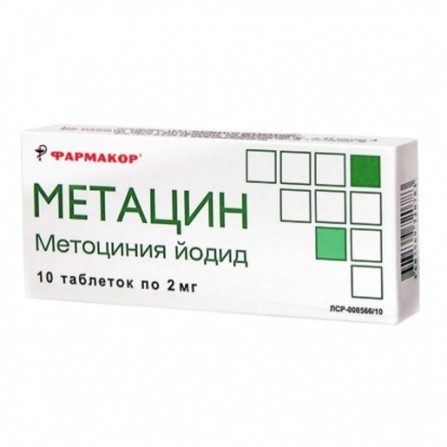More info
Active ingredients
Metocynia iodide
Release form
Pills
Composition
Tablets 1 tab. Metocynia iodide 2 mg.
Pharmacological effect
Pharmacokinetics
Indications
M-cholinergic receptor blocker, monoctertistemic compound. It has a predominant effect on peripheral m-cholinergic receptors. Reduces the tone of smooth muscles of internal organs, reduces the secretion of gastrointestinal glands, bronchial and sweat glands, improves heart rate, improves AV-conductivity. The ability to cause pupil dilation, increased intraocular pressure and accommodation paralysis are less pronounced than in atropine. It has no central action.
Contraindications
Individual. Adults inside by 2-4 mg 2-3 times / day. P / C, in / m or in / in - 0.5 mg / 1 mg 2-3 times / day. Maximum doses: when taken orally, a single dose - 5 mg, daily - 15 mg. with parenteral administration, single - 2 mg, daily - 6 mg.
Use during pregnancy and lactation
C caution should be used in diseases of the cardiovascular system in which an increase in heart rate may be undesirable - atrial fibrillation, tachycardia, chronic heart failure, coronary artery disease, mitral stenosis, hypertension, acute bleeding. with thyrotoxicosis (possibly increased tachycardia). at elevated body temperature (may even increase due to the suppression of the activity of the sweat glands). with reflux esophagitis, hernia of the esophageal orifice of the diaphragm combined with reflux esophagitis (reduced motility of the esophagus and stomach and relaxation of the lower esophageal sphincter can help slow gastric emptying and enhance gastroesophageal reflux through the sphincter with impaired function). in diseases of the gastrointestinal tract, accompanied by obstruction - achalasia and pyloric stenosis (reduced motility and tone, leading to obstruction and delayed stomach contents), intestinal atony in elderly patients or debilitated patients (possible obstruction), paralytic ileus (possible obstruction) . in diseases with increased intraocular pressure - angle-closure (mydriasis, leading to an increase in intraocular pressure,may cause an acute attack) and open-angle glaucoma (mydriatic effect may cause some increase in intraocular pressure. correction of therapy may be required), over 40 years of age (risk of undiagnosed glaucoma). in case of non-specific ulcerative colitis (high doses may inhibit intestinal peristalsis, increasing the likelihood of paralytic intestinal obstruction. In addition, the occurrence or aggravation of such a severe complication, like toxic megacolon, is possible). with dry mouth (long-term use may further increase the intensity of xerostomia). with liver failure (reduced metabolism) and renal failure (risk of side effects due to reduced excretion). in chronic lung diseases, especially in young children and debilitated patients (reduction of bronchial secretion can lead to thickening of the secret and the formation of traffic jams in the bronchi). with myasthenia gravis (the condition may worsen due to the inhibition of the action of acetylcholine). autonomic neuropathy (urinary retention and accommodation paralysis may increase), prostatic hypertrophy without obstruction of the urinary tract, urinary retention or susceptibility to it or diseases accompanied by obstruction of the urinary tract (including bladder neck due to prostatic hypertrophy). with preeclampsia (possibly increased hypertension). with brain damage in children (the effects of the central nervous system may increase). Down's disease (perhaps an unusual dilation of the pupils and an increase in heart rate). central paralysis in children (reaction to anticholinergic drugs may be most pronounced), tachycardia (may increase).
Dosage and administration
Spasm of smooth muscles of internal organs, gastric ulcer and duodenal ulcer, chronic gastritis, biliary and renal colic, hypersecretion of the salivary and bronchial glands, premedication before surgery to reduce the secretion of salivary and bronchial glands, prevention of miscarriage, premature birth.
Side effects
At simultaneous use with m-holinoblokator, the means possessing anticholinergic activity, strengthening of anticholinergic action is possible.
special instructions
At simultaneous use with m-holinoblokator, the means possessing anticholinergic activity, strengthening of anticholinergic action is possible.





